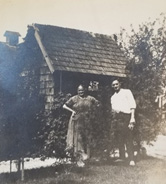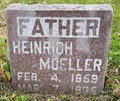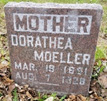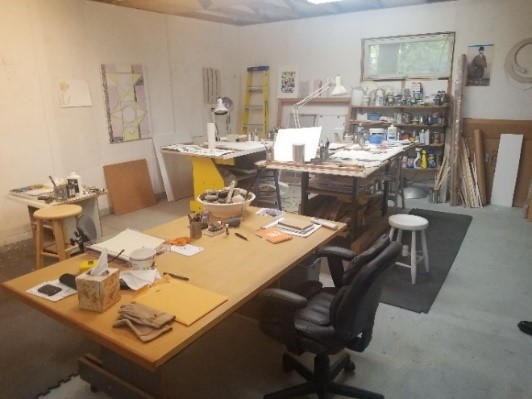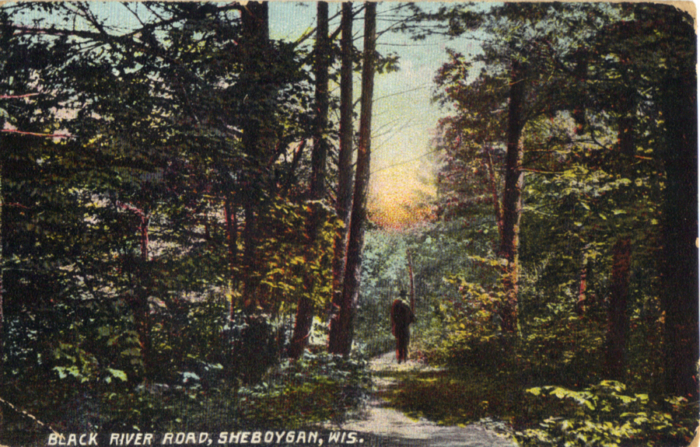
—————
Black River, a gem of Sheboygan County
The Black River Area, a Gem of Sheboygan County”, is an endeavor, a new book, by James Schultz and Beth Dippel to capture the fascinating history of the people and places of Black River, which emerged while researching and compiling materials for the Black River Museum. If you wish to contribute ideas, please contact the Sheboygan County Historical Research Center at 920.467.4667. We’re looking for pictures and stories about life in Black River.
Below you will find two excerpts from the book. The first is a great look at the Henry Mueller Family Conservancy, a centerpiece of the Black River area. The second tells how the Black River area inspired the careers of artist John Clemmer and microbiologist Dorothy Iker Clemmer.
The Henry Mueller Family Conservancy
by James Schultz and Beth Dippel
With all the recent development in Sheboygan County, including a proposal to replace a 247-acre woods by a golf course just a mile away, the Henry Mueller Family Conservancy is more valued than ever. This raises questions about the how the conservancy came to be. Who was the Henry Mueller family? Why does the conservancy have the highly irregular shape shown on the map? Researching these questions uncovered some surprising facts with interesting historical connections.
Accessed from Panther Avenue on the west and bordered by Black River on the east, consisting largely of forest and wetlands, it is home to a variety of wildlife. Ducks, geese, herons, cranes, owls, hawks, turkeys, woodpeckers, and a variety of other birds are seen and heard regularly, as well as migrating hooded mergansers, orioles, grosbeaks, scarlet tanagers, indigo buntings, and occasional eagles. The mammal population includes deer, red fox, coyotes, raccoons, opossums, skunks, muskrats, weasels, and river otters.
The river and creeks contain spawning trout and other fish. The month of May features a chorus of peeper frogs (which could be heard while this is being written within sight and sound of the conservancy!). Parts of the conservancy feature towering birches and evergreens. Two of about twenty wood ducks seen regularly on the river and around the conservancy.
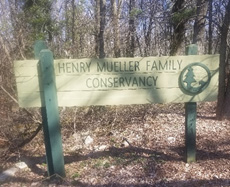
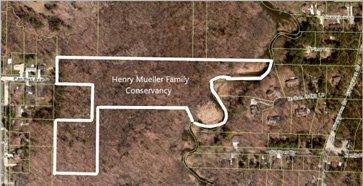

With no less than three Henry Muellers living in Sheboygan County in the early 1900s, it was a challenge to determine which Henry Mueller originally bought the land which was transferred in 1985 to the Town of Wilson by Joan M. Mayer, Esther Mueller Stark, and John R. Lindquist, trustee of the Last Will and Testament and Codicil of Rudie H. Mueller. Not having access to Sheboygan County vital records due to the covid quarantining made identifying the right people even more of a challenge.
It seemed likely that the property traced back to land developer Henry G. Mueller, who with his father developed land in Millersville, named after him. Or was it his son, also named Henry Mueller? Finding no connection between them and those named on the deed transfers (kindly made available by Town of Wilson Supervisor Nancy DesJardins), additional delving uncovered the actual lineage.
The 1935 Sheboygan Press obituary of another Henry Mueller provided the first clue: It told of Henry Mueller, a German immigrant who worked as a longshoreman unloading lumber that came on ships for Sheboygan’s numerous furniture factories and later as a well digger digging many of the wells in the city and county. The obituary and U. S. Census records indicated that Henry and his wife Dorathea (Schmidt) had ten children, one of whom was Rudie Mueller, named in the land transfers. Additional investigating revealed that the connection to two other people named on the land transfers was through another son named Harry. Harry’s daughter Joan, who married Joseph Mayer, was a granddaughter of Henry and Dorathea. Esther Mueller Stark, born Esther Sackett, was the widow of Harry’s son Richard, who died unexpectedly of a heart attack in 1975. After Richard’s death, she married Benjamin Stark. Trustee John Lindquist, named in the transfer documents, was an attorney and the husband of Rudie’s daughter Lois, completing the final link to the right Henry Mueller family.


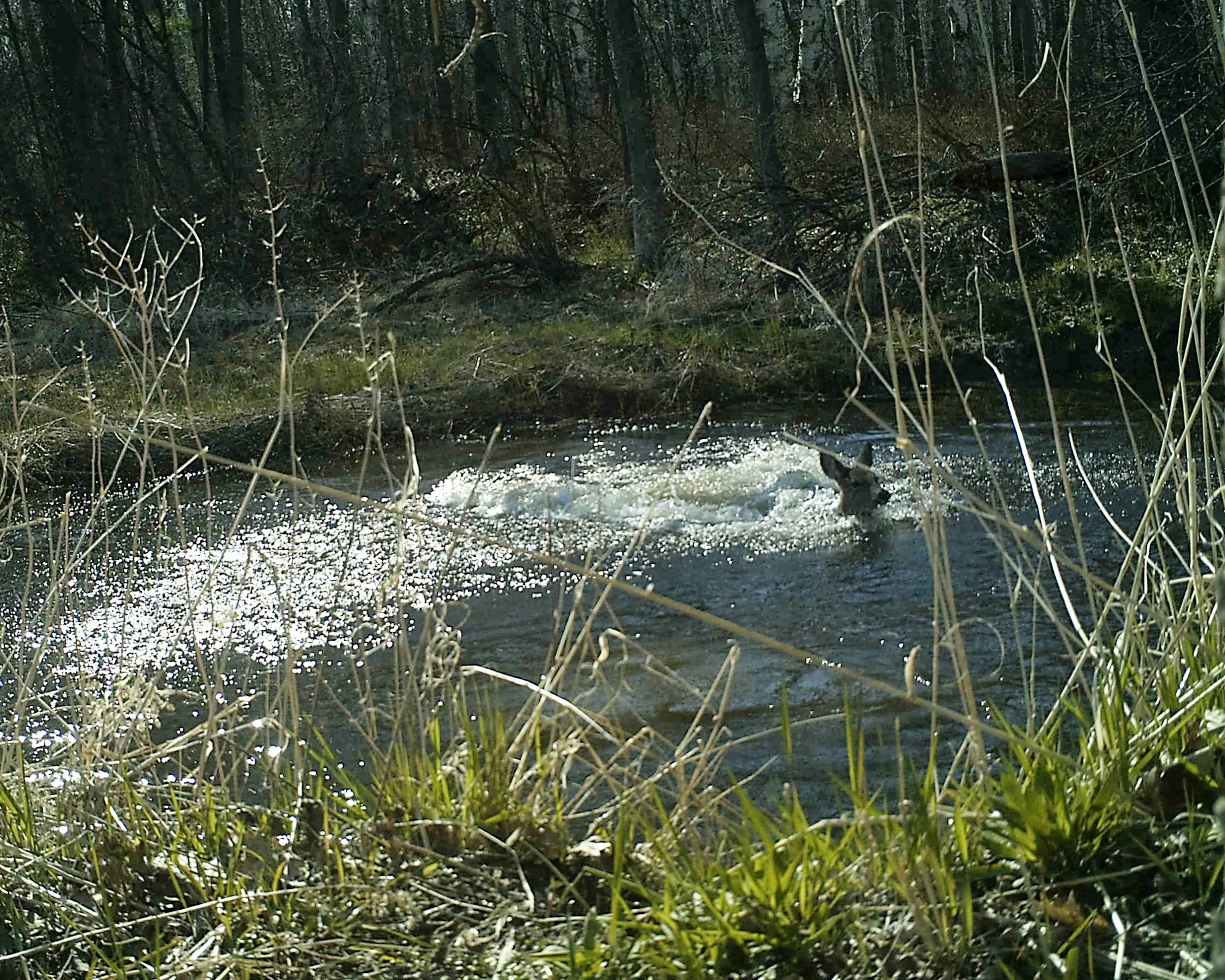
According to their obituaries, Henry was born in 1859 in Sundhausen, near Gotha, in Thuringia, Saxony, and Dorothea was born in 1861 in Michelau in Oberfranken, Bavaria. Ship passenger lists indicate that Henry immigrated in 1884, and his wife and their two youngest children in 1886. Dorathea and her children Frieda and Heinrich, came over on the Eider, a two-funnelled steamer, 430 feet long with four masts, a crew of 167, and capable of carrying 1,204 passengers. (See photo below.) It was on the same ship that Friedrich Trump, grandfather of President Donald Trump, immigrated from Bremen, Germany, a year later at the age of 16. The Eider sank in the English Channel in 1892. Kaiser Wilhelm II gave each coxswain an engraved gold watch after a heroic rescue in which the crew was the last to be taken off the ship.
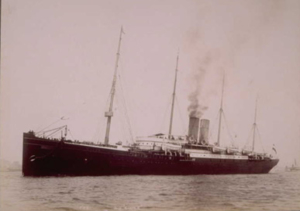
Rich Stephani, who bought land near the conservancy from the Muellers in 1984, recalled that Black River Boy Scouts created trails. He suggested contacting Henry’s grandson, Ted Mueller, who graciously shared several remarkable photos. The military photo, from 1881, is labeled in memory of Henry’s local garrison, which was created in 1807 and reorganized to be part of the 95th Regiment of the Imperial German Infantry. A closer look at the photo reveals the men holding glasses of beer, likely after the ceremony in which the keg in the bottom of the photo was tapped!
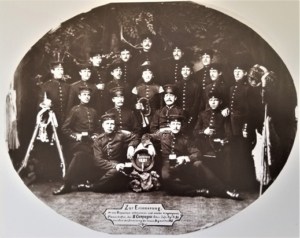
According to Ted, the first photo below is of the family, taken on the Mueller property in Black River in about 1902. Like other photos, it shows that parts of what are now wooded areas in Black River were once farmland. Ted, remembers spending time on his grandparents’ land when he was a child. Ted’s father, Rudie, wrote on the back of the second photo that it was a photo of his mother but didn’t identify the man with her.
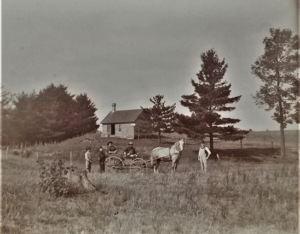
In addition to five children who died in infancy, three adult children preceded Henry in death. Son Henry, Jr. was killed in 1905, knocking apples off a tree while holding the barrel of a loaded shotgun. Daughter Frieda, who married Joseph Rammer in 1916, died in the home of her parents in 1923 after suffering from heart problems. Son Arthur died in 1928, after falling 40 feet to a concrete floor when scaffolding collapsed in the Kohler foundry, leaving behind a widow and nine children during the Depression. Dorathea preceded him in death in 1928. Before his death in 1935, Henry, then 76, had lost his wife and eight children! Henry and Dorathea are buried in Section 1 of Sheboygan’s Wildwood Cemetery, along with several of their children.
The Mueller family did not forget its ties to Germany. Dorathea made a return visit to Germany in 1901. The manifest of the ship Kensington mentions 1884, the year Henry immigrated, his name, and her Sheboygan residence.
The original land transaction in November of 1904 indicates that Henry Mueller and Joseph Frauengruber purchased the 50 acres shown on this 1916 plat map from August Hartman for $1875.
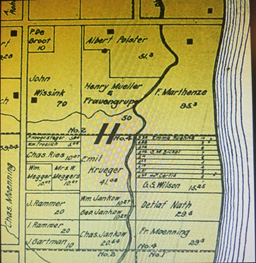
The fifty acres were subdivided into parcels, most which were sold off, leaving the oddly-shaped 12 acres which became the conservancy. The conservancy land was less suitable for building and better protected from development than Wisconsin wetlands today, which can be developed if wetlands are created elsewhere to compensate. The map below shows plans for possible development of the area. It shows 5th and 6th Streets and Lake Shore Drive extending southward and Panther Avenue extending eastward through what became the Mueller Conservancy, cutting it into 26 individual lots. Incidentally, Ted Mueller related that it was his father, Rudie, who named Panther Avenue. It was so-named because the mound builders considered the panther sacred, as evidenced by so many of their mounds being panther-shaped.
Maintaining the wetlands has proven to be prudent, as many of these lots would be flooded with today’s river levels. The question of whether the Mueller land could be developed into a residential area was settled in 1985, when the land became a conservancy, forever preserving the existing character of the land.
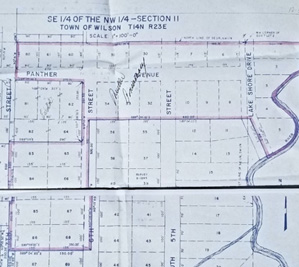
Personal note: Author Jim Schultz, who grew up on the south side of Sheboygan, made frequent trips to Black River in his youth with his friend Marty Kjelson, a descendant of the Jerving family. When relocating to Sheboygan from Ohio in 2005, Jim and his wife Donna Menzer chose a home across the river from the conservancy, a major factor in their decision.
The first photo shows the conservancy as seen from their property. The second shows grandson Ted with the conservancy in the background. The third photo shows Jim in his kayak along side the conservancy.
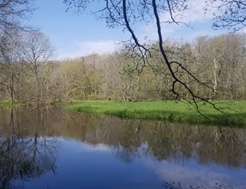


Acknowledgements:
The authors wish to thank Ted Mueller, Nancy DesJardins, Rich Stephani, Nadine Smith, David and Chris Mohar, and Katie Reilly of the Sheboygan County Historical Research Center for their valuable contributions.
+++++
John and Dorothy Clemmer, Inspired by Black River
Artist John Clemmer from southern Louisiana married microbiologist Dorothy Iker from Chicago, but it was the special uniqueness of the Black River area that played a significant part in the careers of both. They are shown in this photo taken by their son David taken in Kohler-Andrae State Park in the southern part of Black River.
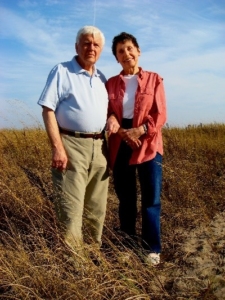
John and Dorothy Clemmer
Kohler-Andrae State Park 2007
Born in 1928, Dorothy grew up in Chicago, where she belonged to the Girl Scouts. She loved to walk in the woods and on the beach while spending summers at the Iker family cottage on Wahgouly Road in the Black River area near Lake Michigan. She collected flowers, leaves, and beach stones and observed frogs, snakes, insects, and wildlife, while pursuing Girl Scout Merit Badges. (Dorothy wrote a wonderful, more detailed description of this as mentioned below.)
With a love for plants and animals instilled in her from her time spent in Black River as a young girl, she began formal studies in biology, going on to get a Ph.D. in microbiology from Tulane University in 1958. She says that her Black river experiences were a major influence on her career choice.
She joined the faculty at the Department of Microbiology, School of Medicine, Tulane University, where she taught medical students. She also worked with the United States Public Health Service, Diarrheal Disease Investigation Unit, New Orleans, Louisiana. Her contributions included being lead author on a paper entitled “Bacteriologic Studies of Experimental Air-Borne Salmonellosis in Chicks” which appeared in The Journal of Infectious Diseases, Volume 106, Issue 2, March 1960.
John was born on a plantation in southern Louisiana in 1921, after his father, a Wisconsin native, married a daughter of a Louisiana family. His family relocated to New Orleans in 1928, where John attended public schools. Following his graduation from high school, he was awarded a scholarship to the New Orleans Art School, but left to serve in the United States Army Air Force during WWII.
John was discharged from the service and returned to New Orleans in 1946. He began exhibiting his work in group exhibitions in 1945 and he had his first solo exhibition in 1948. By 1951 he was the Executive Secretary of the Arts and Crafts Club of New Orleans, the city’s first contemporary gallery, and the Director of the New Orleans School of Art. He began teaching at Tulane University as an instructor in the School of Architecture in 1951, becoming a full professor in 1974. In 1978 he taught Art Fundamentals in the Department of Art of Newcomb College, at that time the women’s college of Tulane University. He went on to become the Chairman of the of the Newcomb Art Department and was the first recipient of the Ford and Maxine Graham Chair in Fine Art. He retired in 1986.
Throughout his career, he exhibited his work in local and regional galleries in Louisiana, Wisconsin, Florida, New York, and California. In the first paragraph of a review of his work entitled “John Clemmer’s Modernist Enterprise”, Judith Bonner wrote the following in The New Orleans Art Review (March April May 2012):
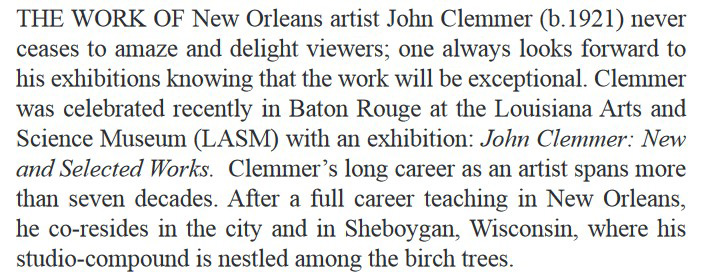
——————–
The photo below appears on the website johnclemmer.com, where more examples of his work can be seen, including work for sale.
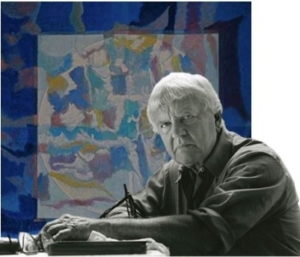
Photo on the website johnclemmer.com
John met Dorothy in 1949 when she was enrolled in drawing classes at the New Orleans School of Art. They were married in New Orleans in 1953 and began spending summers at the Iker family cottage in 1955. John painted his first Wisconsin artwork in 1958. Dorothy said that their making the 1000-mile road trip to Wisconsin during their one-month break was a good indicator of how much they valued coming to the cottage.
John continued to work after retiring from academia, both in New Orleans and on Wahgouly Road. John and Dorothy had acquired the adjoining property in the mid-1970s, where they renovated a second cottage and built a studio for John, shown in the photos below.
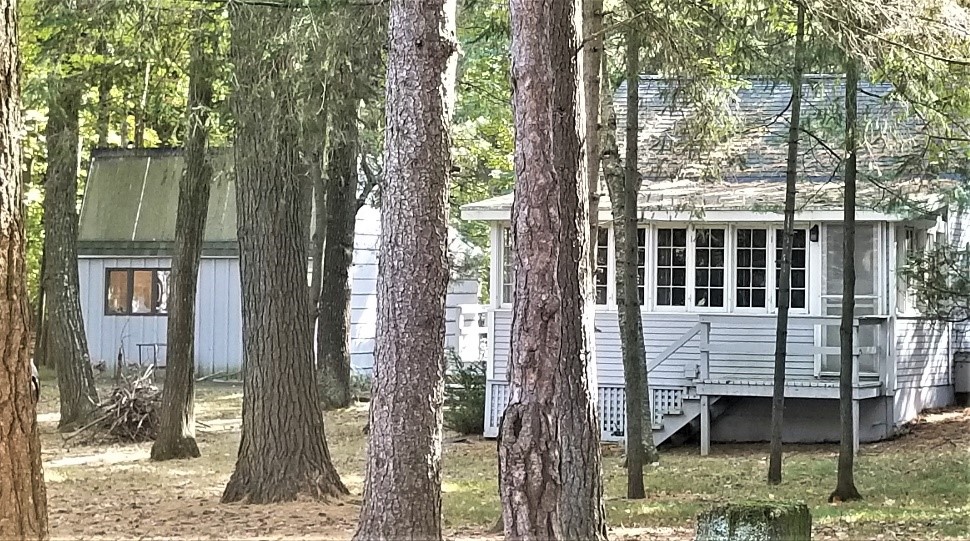
Clemmer Studio and Second Cottage on Wahgouly Road
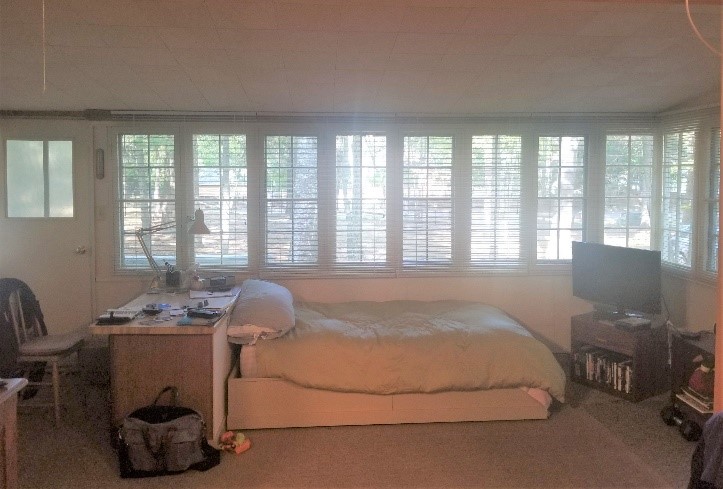
Second Cottage Interior
In the 1990s John and Dorothy replaced the original Iker cottage with an all-season home, which he designed, shown in these two photos. The photo of John in his home was taken in 2012.
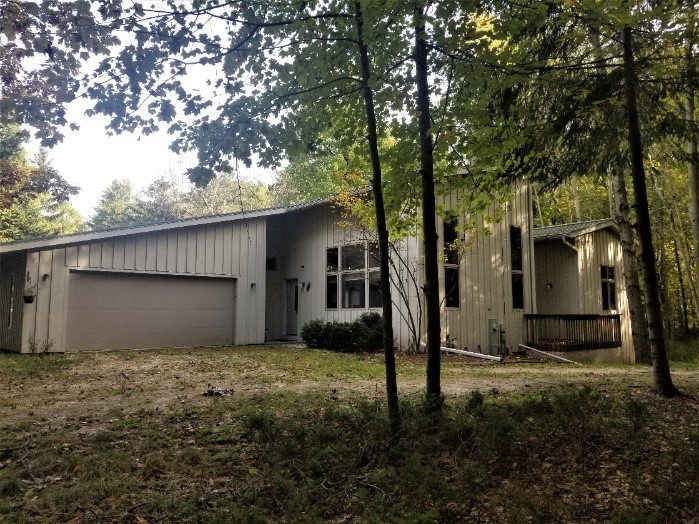
Clemmer-designed home 2019
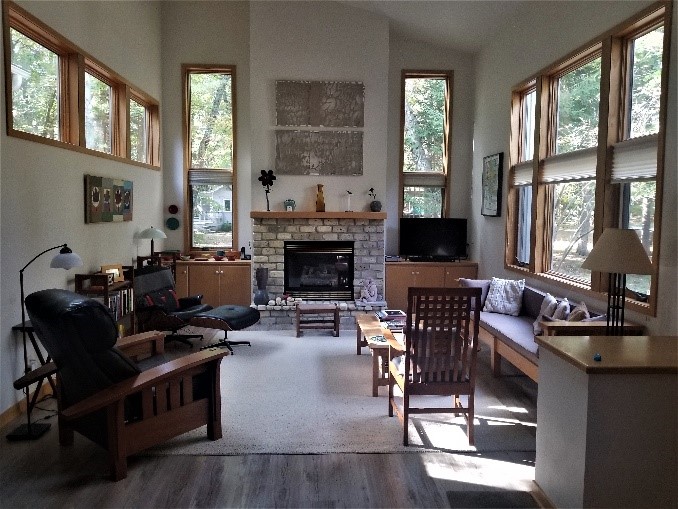
Clemmer home interior 2019
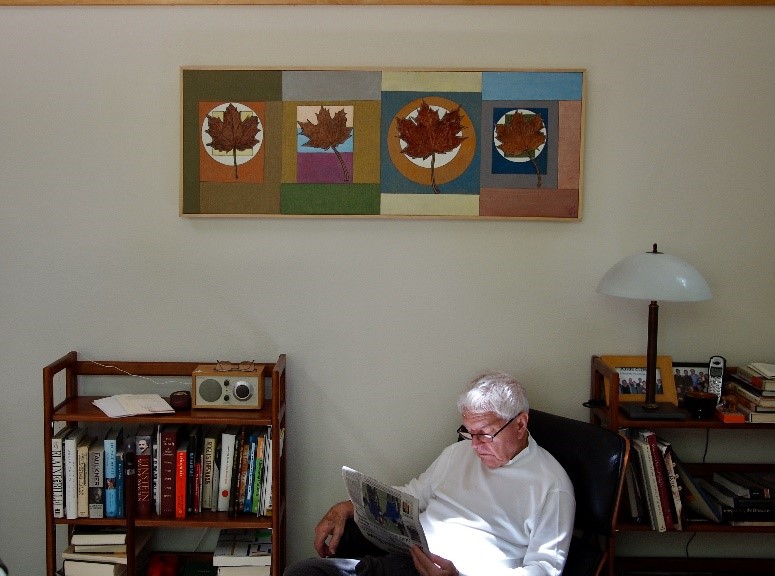
John Clemmer in his home 2012
The influence of the Black River area can be seen in his painting. At that time birch trees abounded in the area, inspiring John to create “Birches Duo” (Oil, 1996-97).

Birches/Duo, 1996-’97
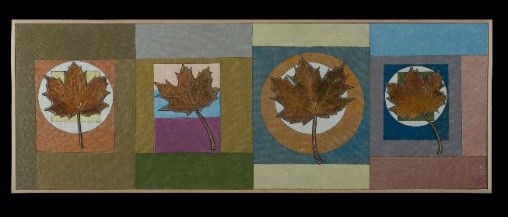
Four Leaves, 2007

Toward Wahgouly 1998
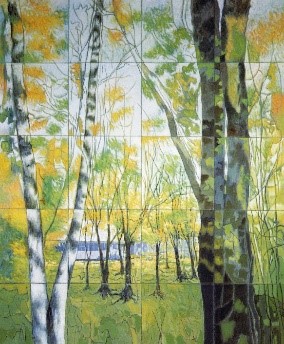
Through the Woods, 1997

Autumn Beach, 2007
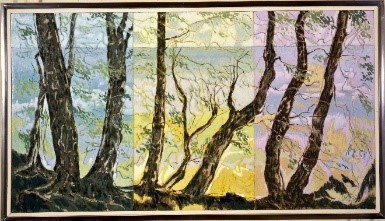
Sister Bay 1998
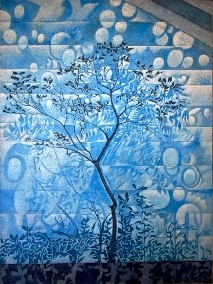
Blue, Studio West 2006

From the Country House 1, 1995
Thus, the special uniqueness of Black River played out in the lives of both Dorothy and John Clemmer, with impact well beyond Wisconsin.
Note: This photo of birch trees in the Mueller Conservancy is the kind of scene that may have inspired John Clemmer to create BirchesDuo.

Birch trees in Mueller Conservancy

Birches/Duo
In 1993 Dorothy Iker Clemmer wrote a colorful and informative history of the area entitled “Memories of Black River 50+ Years Ago by a Summer Cottager” which she concludes by extolling the beauty of Black River.
Note: The authors wish to graciously acknowledge contributions by David Clemmer, Dorothy Clemmer, Jonathan Clemmer, and the review of Judith Bonner cited above. All photos courtesy of Clemmer Family.
Memories of Black River 50+ Years Ago By a Summer Cottager
by Dorothy Iker Clemmer
10/4/1993
Note: With few exceptions, none of the reminiscences below has been verified. They come from a recorded interview with my father, Charles Iker, about his earliest memories of Black River, from my own memory, and from a journal which I started at age 12 years.
My family lived in Chicago. We first came to Black River in July, 1934, when I was 6 years old. We stayed at the Black River Art Colony, a large two story frame building located on the south side of what is now Woodhaven Court. The Art Colony was operated by Mrs. Emma Kuehne, who was described as a lover of nature and the beautiful things of life. Her clientele was composed mostly of professional and amateur artists. I recall watching the guests paint watercolor sketches of the shore and woods.
The tiny guest rooms on the second floor were arranged around a balcony overlooking a lounge area furnished with wicker furniture. We ate family style at long tables. While we were there, Mrs. Kuehne passed away very suddenly and unexpectedly. We were told by her weeping employees that she had driven her car into town and had taken ill. I recall hearing that she had fallen forward on the horn which honked until help arrived. My father was a pallbearer at the funeral and the Art Colony was closed immediately after.
One of the guests at the Art Colony was a well-known Chicago artist, A. Raymond Katz. Several years later, Mr. Katz was commissioned by a Mr. Schmidt to paint the fresco over the fireplace in the new firehouse, now the Black River Advancement Association Hall. In exchange for the painting, Mr. Schmidt, who owned property in Black River, gave the artist a lot just south of the firehouse. The Katz family built a cottage there which I came to know very well. The Katz’s daughter Joan was just my age and we were the closest friends during our long summer vacations in Black River.
In 1937, my family bought our summer cottage at 325 Wahgouly Road for $750. In those days, Black River had more summer cottages than permanent homes. They belonged to residents of Sheboygan who would drive out for weekends. Out cottage had been owned by two bachelors who were reported to have had wild drinking parties on weekends and twice set the cottage on fire. Our next door neighbors, Martha and Arno Feld, were relieved to have a family next door in place of the young men. Martha and Arno were in the process of moving into their new brick home at 317 Wahgouly Road. They had been living in the brick garage while the house was built.
Our cottage needed much refurbishing. Mr. Herman Luebner, a taciturn man, never without his black pipe, began the job. The low ceiling in the living room was torn out to make a gabled ceiling. A tiny bedroom, about 8 ft. square, was given an ingenious window which swung inward and was held up by a metal hook screwed into the ceiling. This was my parents’ room. They said it was just like sleeping outdoors. We three children slept on a tiny porch on army cots furnished with wool army blankets which smelled strongly of moth balls.
We had electricity and a sand point well. The pump was on the front porch. Mother cooked on a kerosene stove. Ice for the ice box was delivered twice or three times a week. A card with large numbers 25, 50, 75 or 100, two on each side, one facing up and the other down, told the ice man how much ice was needed. Milk was delivered, too. There was no sanitary landfill back then. Garbage was buried in a big hole in the back yard. One of the first tasks on arriving for the summer was for father to dig a garbage hole.
Early improvements included a handsome lighting fixture made out of scrap copper by a Mr. Suscha. This hung from the peaked ceiling in the living room. The pump on the front porch was moved into the kitchen and later replaced with running water. An electric stove from Sears Roebuck eventually replaced the kerosene stove and one of the earliest Frigidaires replaced the ice box. Both are still in the cottage and functioning fine.
We didn’t have indoor plumbing until many years later. Meanwhile, we had an outhouse in each sleeping area. There was a covered enamel slop pail for night time emergencies. In 1939, the WPA installed a sanitary privy, one of the many in the area. They were very well constructed and ours is still there with the original certificate of approval on the wall. For many years, we went to the outhouse after dark with a flashlight in hand and once there, lit a candle if the matches weren’t too damp. There was a beautiful beech tree nearby whose branches overhung the outhouse. One of my favorite memories is of sitting out there with a good book after a rain with the water dripping off the branches onto the tine roof. For washing up, we used old fashioned pitchers and bowls. Baths were taken in the lake when the water was warm enough. There was no washing machine, of course, and mother washed our clothes by hand. Sheets were taken to a laundry in town.
There was no public transportation from Black River into Sheboygan. The Katz’s had a car and we were dependent on Mrs. Katz for transportation into town to do serious grocery shopping. This was done primarily at Prange’s where farmers brought fresh produce to be exchanged for store chits. Everyday grocery shopping for milk and bread was done at Marthenze’s Grocery located on the site of the Black River Inn on Evergreen Drive. I remember Mr. Marthenze’s son Jerry, who we thought was very good looking with unusually long eyelashes. The store had a shadowy bar in the back where we could see the dim outlines of customers probably enjoying a beer. This was a place of great mystery and mother would never allow us to go back there.
Food was also purchased at nearby farms. The Jerving farm at the corner of South Evergreen Drive and West Evergreen Drive as a source of chickens. Mrs. Jerving would catch and kill a couple of chickens for mother and Mrs. Katz. I think she took the feathers off, but I can still remember with horror the big yellow feet sticking out the top of a brown paper bag. For fresh eggs, went to the Dicker farm on the south side of EE at the top of the hill. We knew Kurt and Mollie Dicker from the Kuehne Art Lodge when they had both worked. My journal records walking to Mrs. Plum’s for vegetables though I have no memory of where the farm was located.
Fish was purchased directly from the fish houses located at what is now Terry Andre Park. Mother and Mrs. Katz would walk there along the beach. They would try to arrive just as the boats came in. Whitefish was the favorite, although I had no taste for it at the time. Mr. Lester DeZoute, whose father and uncle were fishermen, tells me that the fish houses closed down in 1939. That would have been when I was 11 years old. For decades afterward, our favorite beach walk was down to the fish house, long after the fish houses had ceased to exist.
Joan and I had no trouble keeping busy during the day. We were allowed to roam and we both had bikes. There wasn’t any danger then, at least nothing which would give our parents concern. We would meet in the morning after finishing our chores and decide if we were going to have a beach day or a woods day. We were both Girl Scouts and very serious about earning our outdoor badges. We made flower scrapbooks and leaf scrapbooks much like the ones at the 4-H exhibit at the county fair. We could identify all the trees and most of the wildflowers. We knew where to find wild strawberries, red raspberries and blackberries along the road.
Indian Mound Road was largely undeveloped west of Black River except for the enclave on the north side of the road. The woods on either side were honeycombed with rails which we were told were old logging trails. If you walked to the end of Woodland Road, there were trails leading north. A little way in was an enchanting spot – a small brook, completely unspoiled with small rocks, shallow clear bubbling water with water bugs skating on the top against the current. There were ferns and some larger rocks to cross on. This must have been a branch of Hartmann creek. Beyond, there were low, well defined mounds. We had heard about the Indian Mounds and were sure that these were some, probably correctly. One day, we went farther than we had ever gone before and came out into an enormous field filled with daisies blowing in the wind. I think it was in the meadow that we had a fright. We flushed a pheasant and the whirr of its wings was completely unexpected and shocking in the silence. It took off like a bullet leaving us shaken. We continued on and came out at the Dicker’s farm on County Trunk EE.
Black River itself was also an invitation to explore. The river bank off Indian Mound Road was all overgrown. We would climb down through the cattails to the slippery water edge and try to catch frogs and tadpoles. These were common leopard frogs, bright green and gold, much less common now. Occasionally, we brought them home in jars and once or twice took one home to Chicago where they never survived long despite out best efforts. We invariably slipped on the muddy bank and fell in the water which we thought was very funny. Another fascination were the water lilies. From my journal for July 25, 1941, “This morning we rode down to the river to get some white lilies. In the attempt, Joan cut her hand and for a while felt quite sick. I lost the key to my bike and Joan had to ride home for my duplicate and we got two lilies, one a bud. They’re worth the trouble. I have never seen a more beautiful, fragrant white flower. I insist that it smells like orange blossoms, but mother doesn’t agree.”
On beach days, Joan and I walked down Wahgouly Road to the lake. At the end of the road, a path led through the woods up the dune. I thought this was one of the prettiest paths of all, there were bluebells and columbine along the side and also thick poison ivy. From the top of the dune, you could see empty beach in both directions. To me, this was the prettiest sight of all. In later years, I took pictures looking in both directions from the top of the dune. These hung in my office all year long to remind of the peace and solitude of that beach.
At the top of the dune, we would kick off our shoes and run down the hot sand. The beach in those days must have been at least 100 feet wide. Midway to the water, there was a dune pond, a standing body of brown water, perfectly clear and deliciously warm. Mother would never let us play in the pond however since she was sure there was something contagious in the water. The lake was almost always cold, but we plunged in and were allowed to play there until our fingernails turned blue.
Walking along the shore, there were still commercial fisherman’s buoys to be found. These were highly prized and I still have one along with my collection of favorite stones. The stones were an endless fascination. They were brightly colored when wet and we collected the prettiest only to be disappointed when they dried. There were glass stones and lots of flat stones for skipping. We looked for fossil stones and found many. We were told that there was one type of flat stone that when broken into two flat halves would have a fossil in the middle. We never found one of those, however.
There were also yellow bricks with the edges nicely rounded from years in the water. I began to collect these, too. There seemed to be an endless supply, some years I would find perhaps a dozen and other years only one or two. I still have them. We looked for interesting driftwood, too, and brought home the best pieces. Large logs were always good for walking on. Somehow, the view from the top of the large log looked as if one was very much higher. There were sandbars all along the beach. Through the clear water, the ripples on the sand were beautiful and always in different patterns. We walked sandbars as long as we could, and then swam into the shore again.
Joan and I usually ended our excursions at Marthenze’s Grocery for a refreshment. We each had a nickel to spend. One of us would buy a bottle of soda pop, usually crème or grape and the other would a candy bar, usually a Mr. Goodbar which was the largest for the money. We traded off on the bottle of soda and broke off pieces of the candy bar so that each consumed half.
By the time I was 13, a favorite activity was roller skating at Sterling’s Roller Rink on the corner of Wilson and Lake Shore Drive. The rink was owned by a Mr. Linderman whom everyone called Mr. Sterling. My journal records several excursions during which Joan and I got to flirt with the boys who were there.
The high point of the summer was the Black River Fireman’s Picnic. I could hear the polka music over the loud speaker by mid-morning and by the time I got over to the Katz’s cottage next to the firehouse, the smoke would be rising from the charcoal grills. There was dancing in the firehouse main room with the fireplace. I remember benches placed along the sides and may mothers and children enjoying the music. The Beer Barrel Polka was new then. I noted in my journal that even babies were given sips of beer.
Outside, there were all sort of games. From my journal for July 21, 1941, “We played Bingo and mother won a set of glasses for serving lemonade and such. As this was her lucky day, she won a pencil at the turtle race. The turtle race was one of the most funny and attractive features of the picnic. It was played on a large circular board which had 20 coffee cans with water inserted at intervals. Turtles of all shapes, sizes and descriptions were released in the center and naturally they rushed for the coffee cans. The first turtle to reach a coffee can and scramble in was declared the legal winner and the person who bet on that coffee can was allowed to pick a prize, a prize from articles which ranged from desk lamps to garbage cans.”
Mother and Mrs. Katz declared Thursdays to be maids night out. This meant that the two families piled into the Katz car and into town for the afternoon and ate dinner at a restaurant. These excursions always included a stop at Prange’s. Mother was deathly afraid of escalators. Prange’s was the first place where we were allowed to ride the escalator to the second floor while mother took the elevator and met us at the top. Joan and I headed for the Girl Scout section where all sorts of official Girl Scout equipment was displayed from uniforms to scout knives. Downstairs in the grocery, there was a counter where you could get wonderful butterscotch sundaes. They also sold caramel corn, freshly made, with peanuts in it, the very best. Another stop was the public library on 6th street, now the county courthouse annex. We had summer library cards. They had a children’s section with shelves of books to choose from. I was a voracious reader and often checked out four books at a time.
One of our favorite restaurants was the Chicken Tavern on Pennsylvania near the Sheboygan River. They served fried chicken with a light, crisp crust and salad with a sweet and sour bacon dressing. The portions were tremendous and the parents said it was very reasonably priced. Thimmigs on Pennsylvania and Eighth was another favorite. We kids always had brats and German potato salad. On weekends when father and Mr. Katz were up from Chicago, we sometimes dined at the Heidelberg Restaurant on the top of the bank building. This was very elegant. I always had lamb chops, well done. For us kids the view of the lake and the city from the seventh floor was very exciting. For dessert, we went to Fairmont’s Ice Cream shop on Michigan Avenue where Zurheide’s is now located. It was the first ice cream shop we had seen with more than the basic flavors. I think they had 33. We got double dips and the choice of what to have was tough. My favorite was butter pecan.
Much of what I loved about Black River as a child is still here. The beauty of the woods along Evergreen Drive on a sunny day and the autumn leaves along Indian Mound are still unsurpassed. The red raspberries are still there. I haven’t heard the evening song of the whip-poor-wills in many years, but if I’m out very early for a morning walk, a great blue heron still looks for breakfast in Black River just north of the bridge on Indian Mound. Last summer, we traveled with a friend through Greece visiting fishing villages along the coast of Crete and islands in the Aegean. The friend asked where I’d choose to stay after all the beautiful places we had seen. I said, “That’s an easy question. Black River.”
Originally published by the Black River Advancement Association

